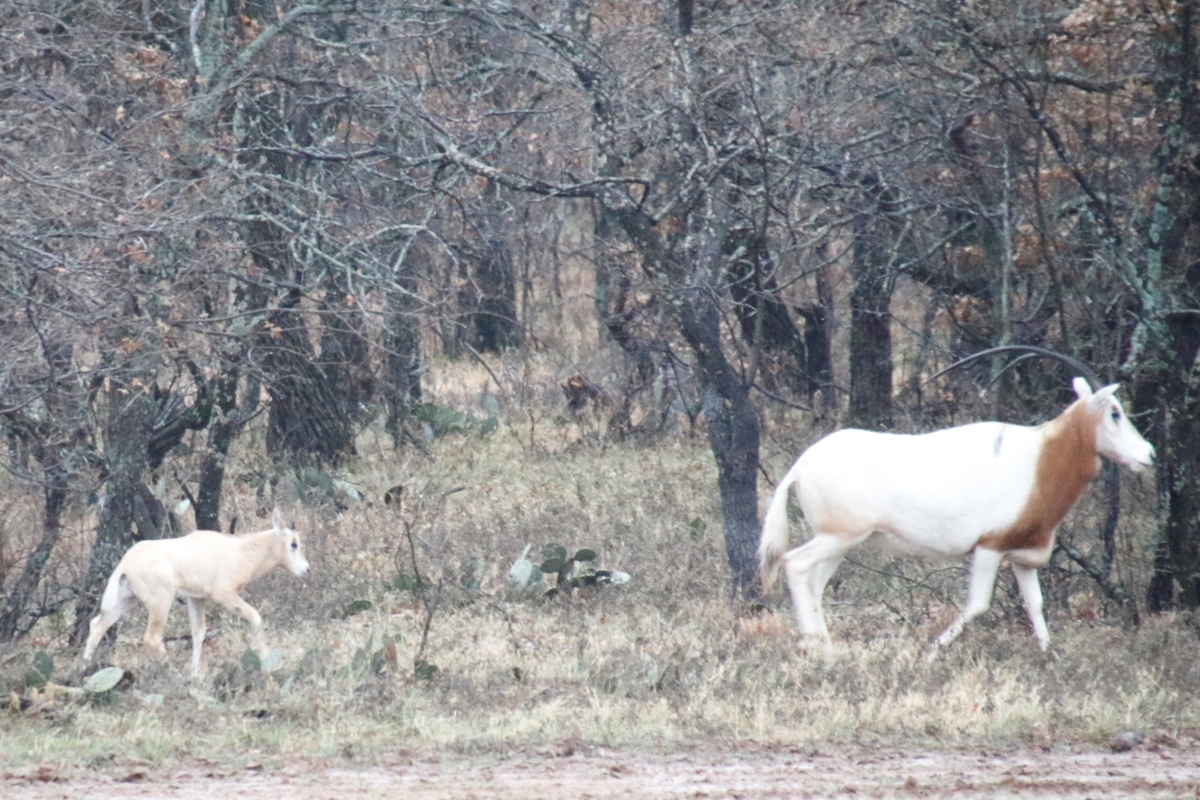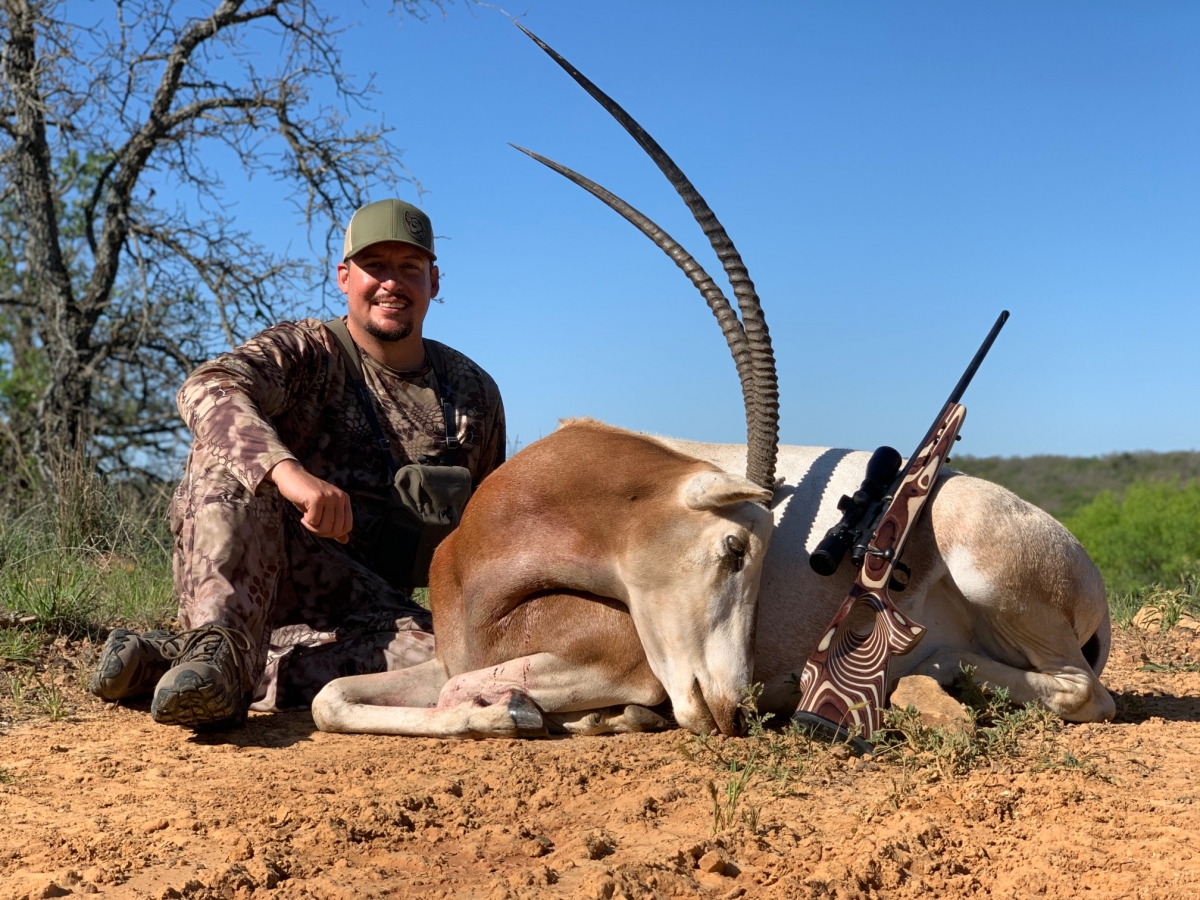
1 Photos
The Scimitar-Horned Oryx was once widespread across North Africa. They are also known as scimitar oryx or Sahara Oryx. The species went extinct in the wild and is on the endangered species list.
The scimitar-horned oryx is named for its long, curving horns, which may grow beyond 36 inches. In fact, this is the only oryx with curved horns. Both males and females have horns, but the female's horns tend to be thinner and the males have more mass. The unicorn myth may have originated from sightings of a scimitar oryx with a broken horn.
Scimitar Oryx are a type of antelope and stand a little over 3 feet at the shoulder. The males weigh 300–450 lbs. and the females weigh 200–325 lbs. They are white with a red-brown chest. The calves are born with a pale yellow coat without distinguishing marks; their coats change to adult colors at 3–12 months old.
They inhabited semideserts and deserts and were adapted to tolerate high temperatures. They have an efficient cooling mechanism and a very low requirement of water. Scimitar oryx feed primarily on foliage and grasses. Most calves are born between March and October. Gestation is between eight to nine months. Only one calf is born. They breed again very soon after their calf is born.
The scimitar oryx was once widespread across northern Africa. Today, they are bred in captivity in special reserves in North Africa and on private ranches in Texas.
Because they have done so well in the US and especially in Texas, Scimitar-Horned Oryx, Addax and Dama Gazelle were given a special exemption by Congress in 2014 from the restrictions of the Endangered Species Act. These three species are sometimes referred to as the “Three Amigos”. So, we are allowed to move these animals from ranch to ranch and to hunt them without the special permits that once were required.
Hatton Ranch received a mixed group of 10 Oryx in November 2016 and 2 bulls in September 2017. They have done extremely well on our ranch. The calves seem to have a very high survival rate. Also, we waited several years to begin hunting them. In early 2021, we estimated our herd size to be around 40 animals. Our largest bull to date was taken recently (May 2021) and had horns of 34 7/8 inches and 35 4/8 inches long. The bases were over 6 inches around. He broke our scale at 409 pounds. Our largest Oryx cow was taken in 2020 and had 36 inch horns. And in case you are wondering, Oryx meat is very delicious. Much better than whitetail in my opinion. I have heard some people talk about how easy an Oryx hunt can be. Well, not on our ranch. They are wild and can be very challenging and elusive. Even though they are white, they can be hard to find in our thick brush. Come see us and give them a try! For a challenging Texas Oryx hunt, call Rich at (214) 802-5952.
Hatton Ranch
Hatton Ranch is a family owned and operated Texas hunting ranch located in Young County near Graham, TX. We are only about 90 to 120 miles west of Dallas and Fort Worth, Texas. We offer guided hunts for whitetail deer, scimitar-horned oryx, and axis deer. In addition, we are a licensed Texas deer breeder and raise whitetail deer with superior genetics to improve our ranch and our customers ranches. We also offer whitetail deer to other breeders to improve their breeding operations.
The Scimitar-Horned Oryx was once widespread across North Africa. They are also known as scimitar oryx or Sahara Oryx. The species went extinct in the wild and is on the endangered species list.
The scimitar-horned oryx is named for its long, curving horns, which may grow beyond 36 inches. In fact, this is the only oryx with curved horns. Both males and females have horns, but the female's horns tend to be thinner and the males have more mass. The unicorn myth may have originated from sightings of a scimitar oryx with a broken horn.
Scimitar Oryx are a type of antelope and stand a little over 3 feet at the shoulder. The males weigh 300–450 lbs. and the females weigh 200–325 lbs. They are white with a red-brown chest. The calves are born with a pale yellow coat without distinguishing marks; their coats change to adult colors at 3–12 months old.
They inhabited semideserts and deserts and were adapted to tolerate high temperatures. They have an efficient cooling mechanism and a very low requirement of water. Scimitar oryx feed primarily on foliage and grasses. Most calves are born between March and October. Gestation is between eight to nine months. Only one calf is born. They breed again very soon after their calf is born.
The scimitar oryx was once widespread across northern Africa. Today, they are bred in captivity in special reserves in North Africa and on private ranches in Texas.
Because they have done so well in the US and especially in Texas, Scimitar-Horned Oryx, Addax and Dama Gazelle were given a special exemption by Congress in 2014 from the restrictions of the Endangered Species Act. These three species are sometimes referred to as the “Three Amigos”. So, we are allowed to move these animals from ranch to ranch and to hunt them without the special permits that once were required.
Hatton Ranch received a mixed group of 10 Oryx in November 2016 and 2 bulls in September 2017. They have done extremely well on our ranch. The calves seem to have a very high survival rate. Also, we waited several years to begin hunting them. In early 2021, we estimated our herd size to be around 40 animals. Our largest bull to date was taken recently (May 2021) and had horns of 34 7/8 inches and 35 4/8 inches long. The bases were over 6 inches around. He broke our scale at 409 pounds. Our largest Oryx cow was taken in 2020 and had 36 inch horns. And in case you are wondering, Oryx meat is very delicious. Much better than whitetail in my opinion. I have heard some people talk about how easy an Oryx hunt can be. Well, not on our ranch. They are wild and can be very challenging and elusive. Even though they are white, they can be hard to find in our thick brush. Come see us and give them a try! For a challenging Texas Oryx hunt, call Rich at (214) 802-5952.
Hatton Ranch
Hatton Ranch is a family owned and operated Texas hunting ranch located in Young County near Graham, TX. We are only about 90 to 120 miles west of Dallas and Fort Worth, Texas. We offer guided hunts for whitetail deer, scimitar-horned oryx, and axis deer. In addition, we are a licensed Texas deer breeder and raise whitetail deer with superior genetics to improve our ranch and our customers ranches. We also offer whitetail deer to other breeders to improve their breeding operations.

